Watch
To celebrate the theme The Next Generation: Strength, Vision & Legacy, Di-Di Vaha’akolo interviewed Lennox Monaghan who plays Percy Boy Collins in Windcatcher.
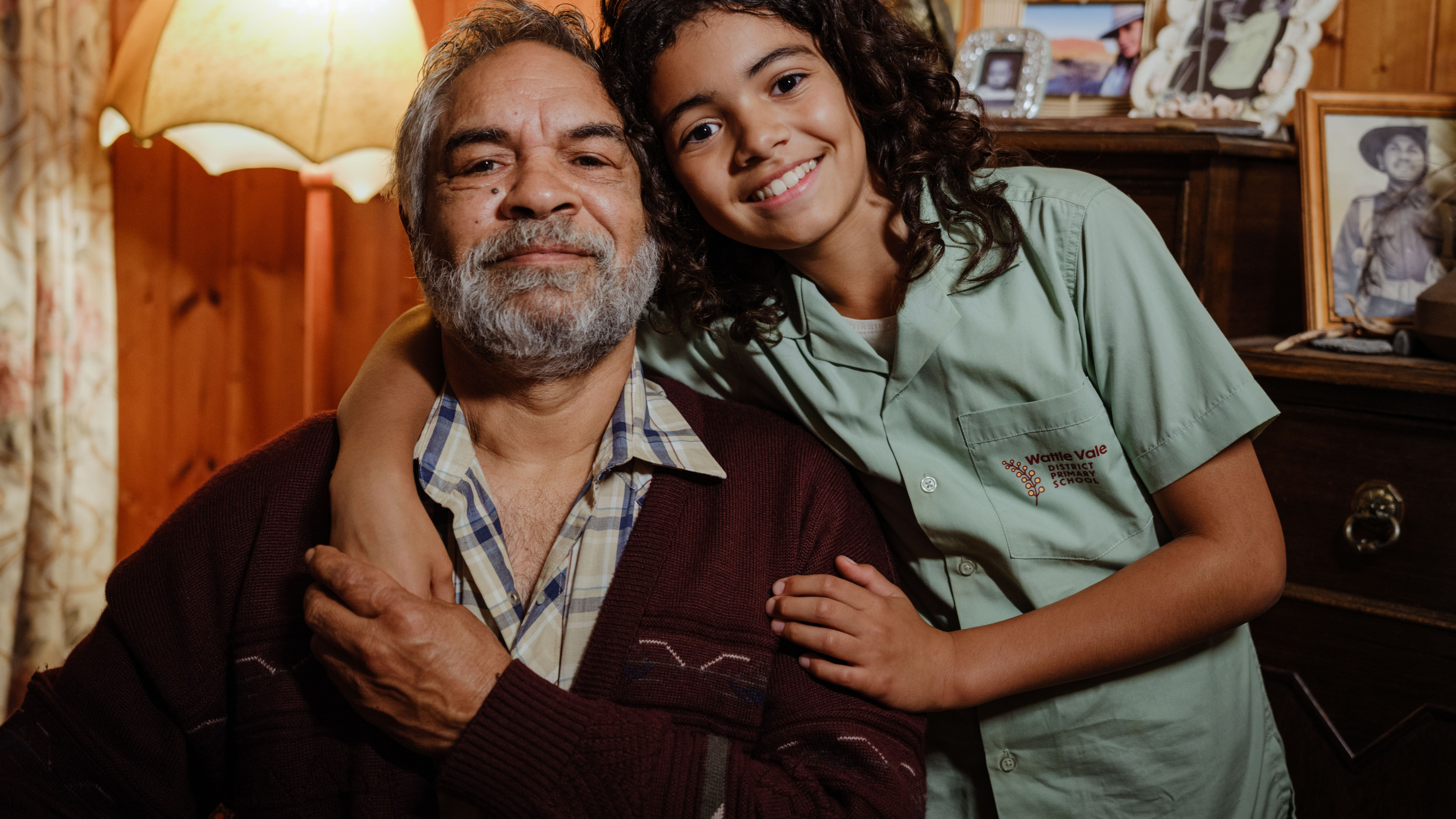
NAIDOC week is an opportunity for students to celebrate and champion First Nations screen stories in the classroom. The official week is 6 - 13 July 2025, with schools planning for activities throughout the year. The 2025 theme, The Next Generation: Strength, Vision & Legacy, celebrates not only the achievements of the past but the bright future ahead, empowered by the strength of young leaders, the vision of communities and the legacy of ancestors.
This resource provides a series of short clips, interview material and activities for students in Years 4 - 8. The Legacy Tree activity can be adapted for younger or older students.
“Remember Percy Boy, keep your head down when you work, keep your chin up in adversity and always keep your fists to yourself and the opposite with your heart, keep that open.”
- Pop, Windcatcher
To celebrate the theme The Next Generation: Strength, Vision & Legacy, Di-Di Vaha’akolo interviewed Lennox Monaghan who plays Percy Boy Collins in Windcatcher.
Hold a class discussion answering the following questions:
Lennox mentioned the importance of First Nations storytelling on screen. Why do you think it is essential for First Nations voices to be represented on screen?
Who inspires Lennox as a young First Nations actor? Why do you think it’s important to have role models?
In Windcatcher, we see the strong and caring relationship between Percy Boy and his Pop. As you watch the following scenes, look at how Pop shares his stories, knowledge and values with Percy Boy. These moments show how Pop is passing down his legacy, his experiences, culture and wisdom, helping Percy Boy understand who he is and where he comes from.
What are some things Pop teaches Percy Boy?
Why do you think these lessons are important to Percy Boy?
What do you think the word "legacy" means?
What kind of legacy is Pop passing down to Percy Boy?
Can you think of something an older person in your life has taught you? It could be a skill, a story, or advice.
Why is it important for young people to learn from older generations?
In this project, you will create a part of a large tree display that represents the strength, vision and legacy of your class. You will make a leaves to symbolise your own strength and potential and roots and branches to honor the people who have supported and helped you grow. Together, your artwork will show how the past, present and future are connected.
A tree represents strength, resilience and growth. It also shows how we are connected to our past, present and future. In this project, you will download, print and decorate leaves, a branch and a root. Then, as a class you will decorate your tree's trunk.
Leaves
Your leaves represents your own strength and vision for the future. Think about what makes you strong, what you want to achieve or how you want to grow. Decorate your leaves with symbols, colours or words that show your personal strength or what you hope to do in the future.
Download and print the below worksheet on A4 paper.
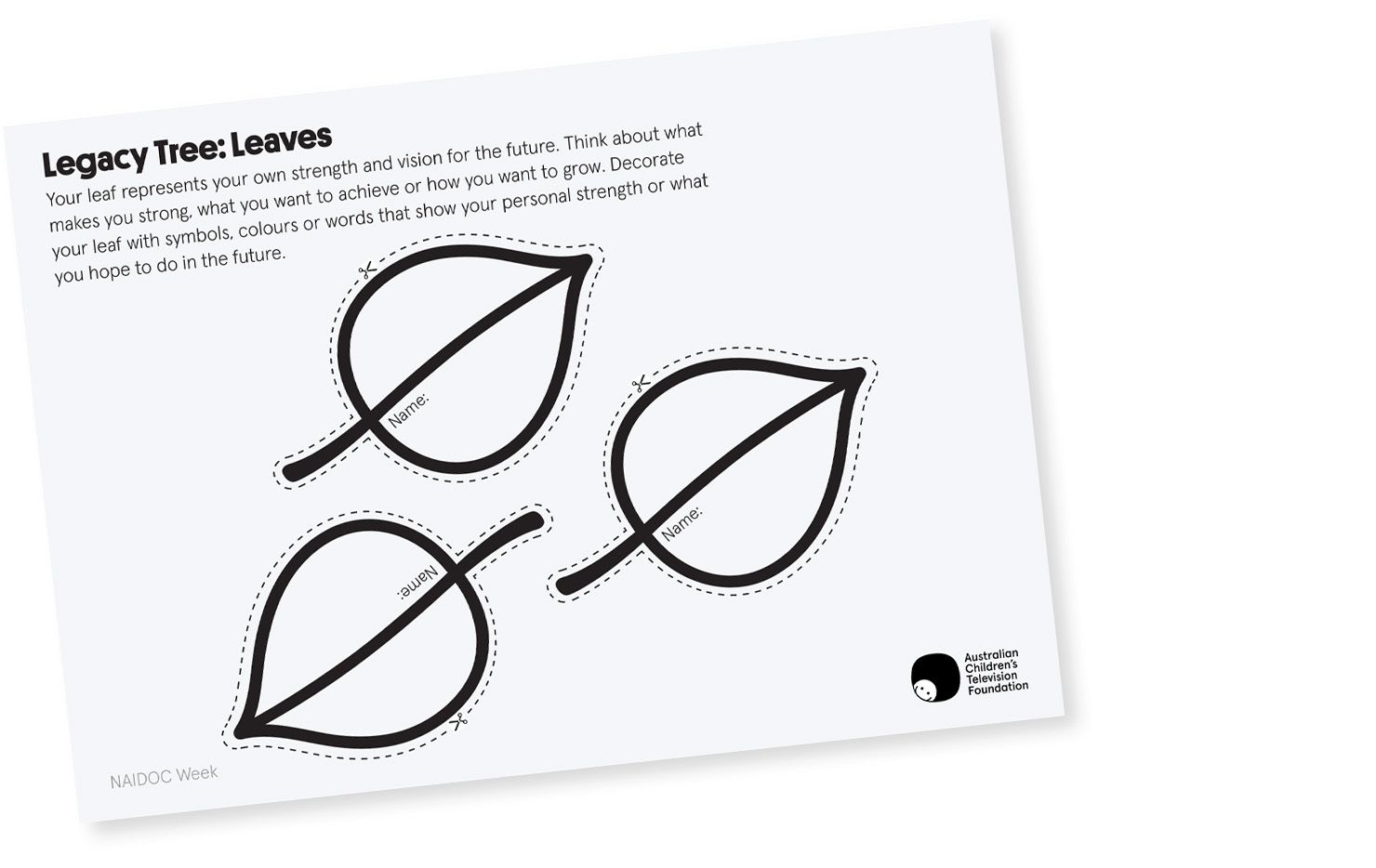
Branch
The branch represents someone who continues to support and guide you today, like a teacher, friend or role model. Decorate your branch with symbols, colours or words that show how this person helps you grow and become stronger.
Download and print the below worksheet on A4 paper.
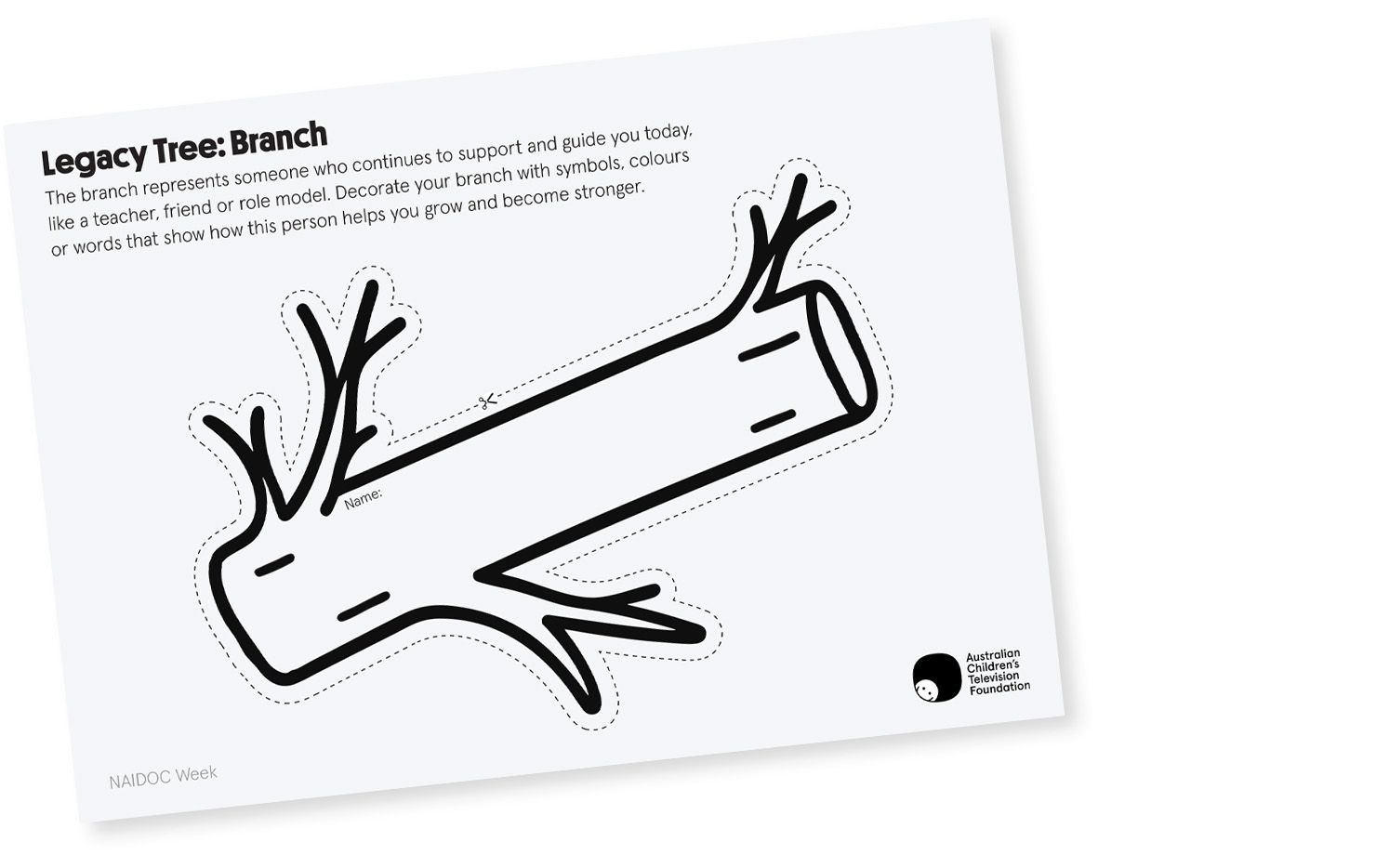
Root
The root represents someone who has given you wisdom, strength or support in the past. This could be an Elder, a family member, a teacher or a friend. On your root, write or draw something that shows how this person has helped you or what you have learned from them.
Download and print the below worksheet on A4 paper.

Trunk
The trunk brings all the elements of your class together and holds the legacy you are creating as a group. It represents your shared strengths and vision for the future. As a class, decorate the trunk with symbols, colours or words that show what makes your class unique.
Download and print the below 3 worksheets on A3 paper.
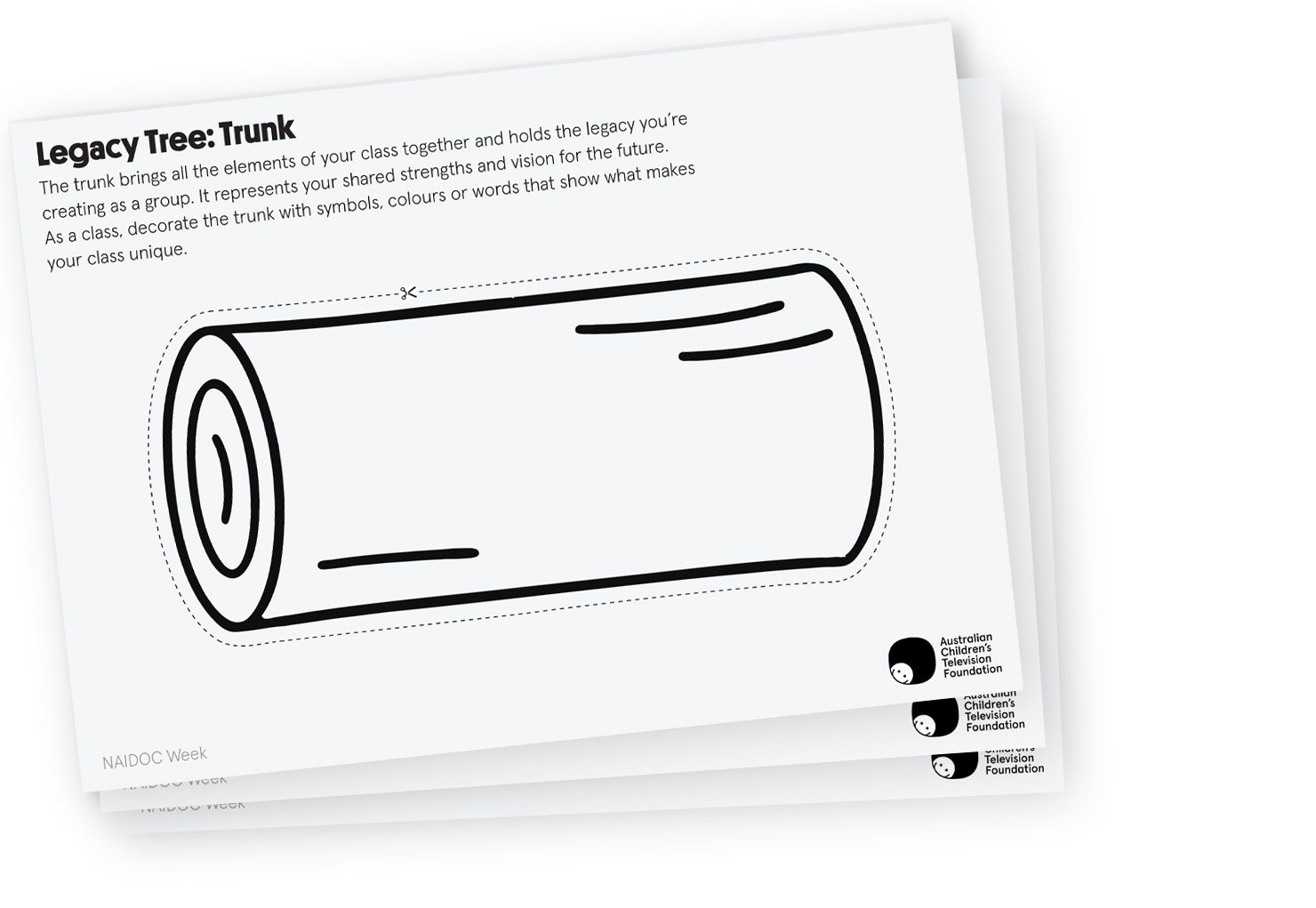
Create a large tree display on the board or on the wall in the classroom by adding your leaves, branch, root and trunk:
Here’s an example of how your Legacy Tree display might look when all the parts are joined together.
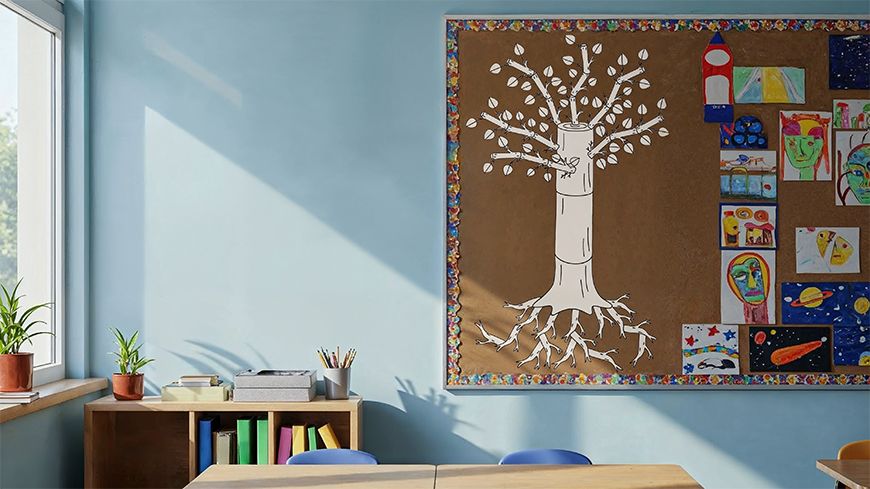
After you have added your pieces to the display, step back and look at the tree. Hold a class discussion answering the following questions:
We would love to see your Legacy Tree display. Send a photo to education@actf.com.au.
This resource was developed in collaboration with Di-Di Vaha’akolo.
Di-Di Vaha’akolo is a Yorta Yorta, Wemba Wemba, Taungwurrung, Tongan and Fiji-Indian woman, born and raised on Boon Wurrung and Wurundjeri Country. With the guidance of her Elders and community, Di-Di has gained a strong passion and deep understanding of her First Nations cultures and heritage from around the world. Di-Di has extensive knowledge in creating and facilitating educational programs and workshops about First Peoples knowledge and histories from south-eastern Australia to a diverse range of audiences.
|
Year 4 |
Year 5 |
Year 6 |
Year 7 |
Year 8 |
||||
|
explore where, why and how media arts is created and/or distributed across cultures, times, places and/or other contexts |
|
|
||||||
|
AC9AMA4E02 |
explore ways First Nations Australians use media arts to continue and revitalise cultures |
investigate the diversity of First Nations Australians’ media arts works and practices, considering culturally responsive approaches to Indigenous Cultural and Intellectual Property rights |
||||||
|
Year 4 |
Year 5 |
Year 6 |
Year 7 |
Year 8 |
|
listen for key points and information to carry out tasks and contribute to discussions, acknowledging another opinion, linking a response to the topic, and sharing and extending ideas and information |
use appropriate interaction skills including paraphrasing and questioning to clarify meaning, make connections to own experience, and present and justify an opinion or idea |
use interaction skills and awareness of formality when paraphrasing, questioning, clarifying and interrogating ideas, developing and supporting arguments, and sharing and evaluating information, experiences and opinions |
use interaction skills when discussing and presenting ideas and information including evaluations of the features of spoken texts |
use interaction skills for identified purposes and situations, including when supporting or challenging the stated or implied meanings of spoken texts in presentations or discussion |
|
plan, create, edit and publish written and multimodal imaginative, informative and persuasive texts, using visual features, relevant linked ideas, complex sentences, appropriate tense, synonyms and antonyms, correct spelling of multisyllabic words and simple punctuation |
plan, create, edit and publish written and multimodal texts whose purposes may be imaginative, informative and persuasive, developing ideas using visual features, text structure appropriate to the topic and purpose, text connectives, expanded noun groups, specialist and technical vocabulary, and punctuation including dialogue punctuation |
plan, create, edit and publish written and multimodal texts whose purposes may be imaginative, informative and persuasive, using paragraphs, a variety of complex sentences, expanded verb groups, tense, topic-specific and vivid vocabulary, punctuation, spelling and visual features |
plan, create, edit and publish written and multimodal texts, selecting subject matter, and using text structures, language features, literary devices and visual features as appropriate to convey information, ideas and opinions in ways that may be imaginative, reflective, informative, persuasive and/or analytical |
plan, create, edit and publish written and multimodal texts, organising and expanding ideas, and selecting text structures, language features, literary devices and visual features for purposes and audiences in ways that may be imaginative, reflective, informative, persuasive and/or analytical |
Ten-year-old Percy Boy Collins and his eclectic crew of friends outsmart a gang of bullies to triumph at their school’s athletics carnival, emerging as heroes of their own epic adventure.
Developed for Years 5 to 8, this resource provides sequenced learning tasks suitable for a whole-class film study. These English tasks build students’ knowledge of viewing processes, including planning, monitoring, reflecting and reviewing. Behind-the-scenes materials and promotional materials are incorporated for student engagement and understanding.
This resource provides a series of curated, age-appropriate screen stories, with a discussion point and creative response for students in Foundation to Year 10. Invite culture leaders and knowledge holders featured in these screen texts into the classroom for NAIDOC and beyond – to celebrate the resilience, generosity, creativity, and enduring strength of the oldest living culture in the world.
We are proud to present these engaging learning tasks for students in F-10. The leading knowledge holders who feature on our screens are to be shared for NAIDOC and beyond – to celebrate our Elders.
This resource centres on the personal and social skills and understandings that are explored in each episode of the children’s series, Eddie’s Lil’ Homies. It includes concepts, discussion starters and hands-on learning tasks that support Foundation to Year 2 students to understand themselves and others, supporting them to navigate relationships in the classroom and beyond.
This Thalu resource centres on character-led storytelling, with a strong connection to Country. It includes learning intentions, discussion starters and hands-on learning tasks that support Year 3-Year 6 students to build skills in English and Media Arts.
Developed for students in Years 3-6, this resource aligns with English, History and Social Science (HASS) and Media Arts content in the Australian Curriculum. It also builds knowledge of Aboriginal and Torres Strait Islander Histories and Cultures.